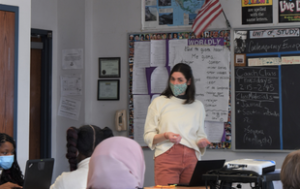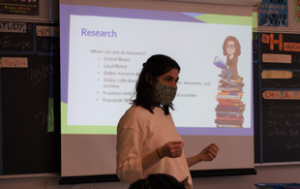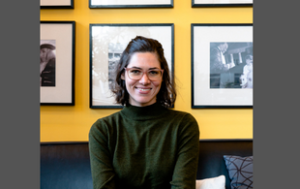Last fall, the Library of Congress Teaching with Primary Sources program awarded us $82,188 to support a Maryland History Day for English Learners Curriculum, featuring a collection of lesson plans and worksheets. We’re in the creation stage of this project, and we recently spoke about it with Lia Atanat, Maryland History Day Outreach & Professional Development Coordinator.
Materials focus on teaching English learners primary source research skills and include professional development resources for educators. The funding will also allow us to build upon our 200 existing History Inquiry Kits and support the creation of 16 new kits for English learners.

Q: Can you talk about your own background with education for English learners?
A: I have a Certificate in Teaching English to Speakers of Other Languages and taught English for Academic Purposes on the faculty of an English preparatory program at a university in Istanbul. I was part of a committee to create a series of mini-projects at each level for language development and assessment. English language teaching values project-based learning for its potential for authentic assessment. This means that project-based learning uses activities that develop skills that students will need outside the classroom. Assessment considers the variety of tasks and skills that go into the project, instead of a more conventional test that might not accurately measure outcomes for English learners. Maryland History Day is an example of project-based learning and develops skills that students use long after the project is over. There’s this great crossover potential to use this in English language teaching.
Q: How can English learners benefit from Maryland History Day programming? What are you hoping students get out of it?
A: In a way, English learners can benefit from Maryland History Day the same way that their native English-speaking peers have. It’s an academically rigorous curriculum that helps students develop historical thinking skills. Students who participate in History Day outperform their peers in evaluating online sources, ability to organize a report, and a wide range of other skills that they are exposed to through this program. The difference is that schools, historically, have not prioritized academic rigor for English learners, so it’s a matter of educational equity to make sure they are getting the same opportunities for rigor and college and career prep that their native English-speaking peers are. In addition to that, as I mentioned before, project-based learning is a darling of the English teaching world since it gives authentic opportunities for different types of language input and output—reading, writing, listening, and speaking—and situational language, like that needed for group collaboration and judge interviews.
 Q: What will the Maryland History Day for English learners curriculum look like? How will it differentiate from the other Maryland History Day curricula?
Q: What will the Maryland History Day for English learners curriculum look like? How will it differentiate from the other Maryland History Day curricula?
A: The Maryland History Day for English Learners resources are currently being created by a small team of ESOL (English for Speakers of Other Languages) educators in Maryland who also have experience in teaching or aiding social studies classes with English learners. The finished product will be a collection of lesson plans and worksheets that guide teachers and students through the process of History Day, from choosing a topic to doing research to putting it all together. In creating the collection, we’re paying special attention to the modeling and scaffolding (examples and structure) that makes content learning easier for English learners. Our resource creators are working to incorporate outcomes for language development as well as for social studies skills. We hope these resources will make it easier for teachers of English learners to implement this project with their students.
Q: What excites you most about this work?
A: I’m always excited to see what students are curious to learn about. I judged a school contest and met a Kuwaiti student who had researched the Gulf War. At a classroom visit, I met a group of Mexican students doing a project on the Treaty of Guadalupe Hidalgo. But I’ve also encountered groups of English learners who chose to do projects on JFK, women’s suffrage in the US, and the French Revolution. Students find points of entry in all different sorts of topics, and that element of choice is a great motivator. And it’s exciting to see them taking pride and ownership of the work they’ve done, because they chose the topic, decided what they wanted to say about it, and became the experts in it.

Q: How do you see this fitting into Maryland Humanities’ overall work/mission/vision?
A: As Maryland Humanities’ mission has evolved and crystallized in the past few years, we’ve become more serious about putting our beliefs about racial equity into practice. Creating opportunities for English learners is a matter of racial equity, since the majority of English learners are students of color who have historically faced an opportunity gap in education. I think we’ll still have a long way to go to see greater racial equity for ELs in schools—I’d love to see more bilingual education programs in Maryland, for a start, and recognition of the ways that education in the US has been shaped by white supremacy—but making this program more accessible is a small first step.
Apart from enabling students to build academic skills, Maryland History Day also allows students to find a way to connect to the humanities and explore their own identities, interests, and values through the stories they tell about the past. It’s important for us to be truly statewide and engage with as many Marylanders as we can, so it will be exciting to see how enthusiasm for this program might spread from these students to their families and communities.
Q: What about the state of Maryland makes this work important?
A: Right now, an average of 10% of K-12 students in Maryland are English learners, as high as 20% in Prince George’s County, and the number is growing across the state. We are at a point where monolingual English-speaking Americans are starting to realize—or need to realize—that being multilingual is an asset, not a barrier. And it’s the responsibility of all teachers to recognize the needs of English learners in their classes and help them get to college and career readiness. English learners bear a much heavier cognitive load when they come to school every day. They are working to acquire content and academic skills along with their peers, but doing so in their second (or third, or fourth) language. Those coming from other countries or cultural communities might also be settling in to a new set of social and school-based expectations. But the fact that they are learning English should be no more of a barrier than the fact that they are learning how to write a thesis statement—both take practice.
Q: What has been the biggest struggle with this programming?
A: I think that even as we reach more English learners with this program and hopefully see them benefitting from it academically, we will still struggle with making the Maryland History Day contests as equitable as possible. All students are capable of working hard and doing good research, but not all of them will have extra afterschool help sessions, trips to the archives, or paid subscriptions to sophisticated video-editing software to make a documentary. It’s something that the MHD team is constantly thinking about and that we’ll likely need to continue to think about for a long time. Luckily, we do have grant funding from the National Endowment for the Humanities through their A More Perfect Union initiative to be able to offer mini-grants to schools next fall for things like subscriptions to NoodleTools (an online bibliography tool) and buses for field trips to history museums.
Q: Is there anything you’d like to add?
A: We’ll be piloting our resources with teachers next school year to gather feedback. I’m looking forward to introducing History Day to a new group of teachers—content teachers with English learners and ESOL teachers—who might not have heard of it or might not have considered History Day as an option before. Teachers who are interested should keep an eye on our social media to learn more.
I also want to share that the creation of these resources was made possible by the Library of Congress through their Teaching with Primary Sources (TPS) Program. If you teach with primary sources, whether you teach history or art or science, kindergarteners, college students, or and everyone in between, you can find a wide range of teaching materials, online interactives, and professional development opportunities coming from the organizations that form this consortium.
Teaching with Primary Sources (TPS), a complement to Maryland Humanities’ Maryland History Day program, is a partnership between Maryland Humanities, Maryland Public Television, and the Maryland State Department of Education.

